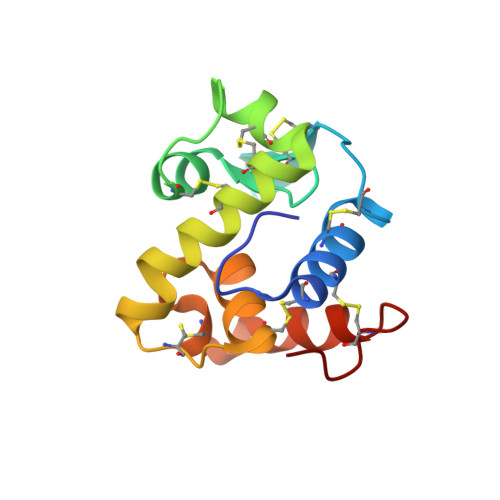Crystal Structure of Tapes japonica Lysozyme with Substrate Analogue: STRUCTURAL BASIS OF THE CATALYTIC MECHANISM AND MANIFESTATION OF ITS CHITINASE ACTIVITY ACCOMPANIED BY QUATERNARY STRUCTURAL CHANGE
Goto, T., Abe, Y., Kakuta, Y., Takeshita, K., Imoto, T., Ueda, T.(2007) J Biol Chem 282: 27459-27467
- PubMed: 17631496
- DOI: https://doi.org/10.1074/jbc.M704555200
- Primary Citation of Related Structures:
2DQA - PubMed Abstract:
Tapes japonica lysozyme (TJL) is classified as a member of the recently established i-type lysozyme family. In this study, we solved the crystal structure of TJL complexed with a trimer of N-acetylglucosamine to 1.6A resolution. Based on structure and mutation analyses, we demonstrated that Glu-18 and Asp-30 are the catalytic residues of TJL. Furthermore, the present findings suggest that the catalytic mechanism of TJL is a retaining mechanism that proceeds through a covalent sugar-enzyme intermediate. On the other hand, the quaternary structure in the crystal revealed a dimer formed by the electrostatic interactions of catalytic residues (Glu-18 and Asp-30) in one molecule with the positive residues at the C terminus in helix 6 of the other molecule. Gel chromatography analysis revealed that the TJL dimer remained intact under low salt conditions but that it dissociated to TJL monomers under high salt conditions. With increasing salt concentrations, the chitinase activity of TJL dramatically increased. Therefore, this study provides novel evidence that the lysozyme activity of TJL is modulated by its quaternary structure.
Organizational Affiliation:
Graduate School of Pharmaceutical Sciences, 3-1-1 Maidashi, Higashi-ku, Fukuoka 812-8582 and.


















